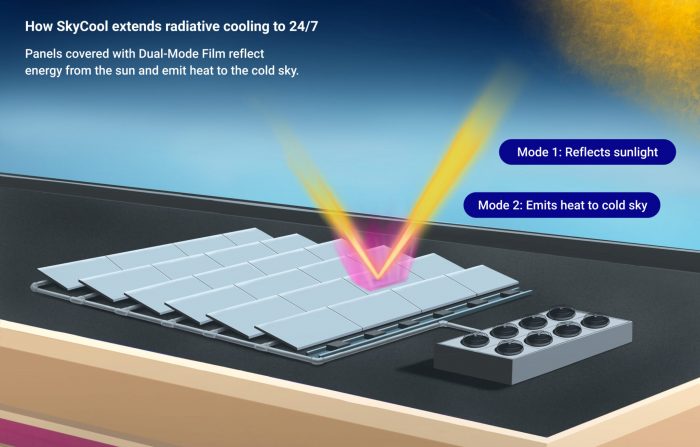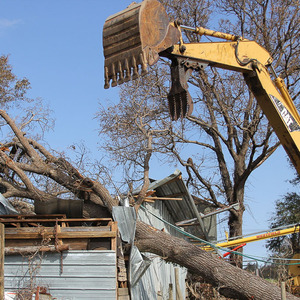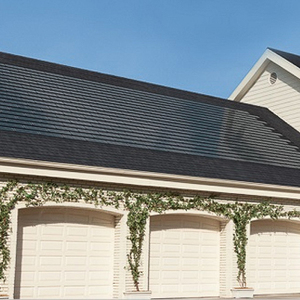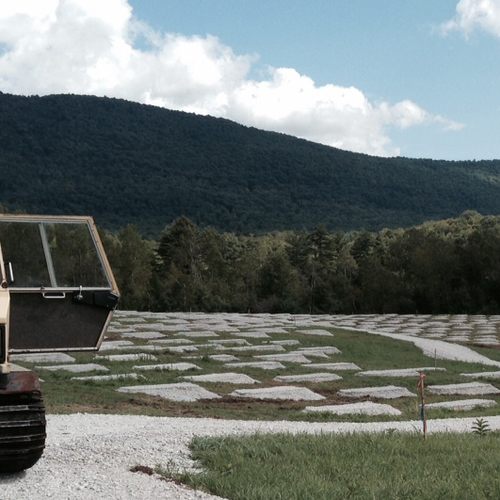
We associate radiative energy with heat, as in the case of as sun rays warming a winter greenhouse. Now imagine sunlight used for cooling. Contrary to our everyday experience, researchers at SkyCool Systems have patented the technology to turn bright, broad daylight into a renewable source for air conditioning. According to the company, their cooling panels reflect heat toward the sky and beyond the atmosphere. The system works only during the day and performs best in hot, sunny climates, such as Southern California. Unlike heat pumps, air-conditioning units, or standard solar arrays that contribute to the heat-island effect, the SkyCool units don’t dump heated air back into the environment.
The SkyCool panels emit thermal radiation through our atmosphere to the cold of outer space. The company claims their units will save three times the energy produced by a similar array of photovoltaics. The technology involves a thin, multilayer film developed by Aaswath Raman, an engineering professor at the University of California Los Angeles. The film reflects both visible light and infrared wavelengths transparent to the blanketing effect of the atmosphere.
In an article in National Geographic, Raman compares the atmosphere to a blanket with holes in it. By developing materials that emit infrared radiation at the specific wavelengths that escape through those “holes” in the atmosphere, Rama achieved the elusive goal of creating a substance that cools itself, well below ambient temperatures, without using electricity. In other words, passive-solar cooling.
Practical applications
Today, Raman is involved in a project called Heat Resilient Los Angeles that aims to install passive cooling systems throughout the city to demonstrate a solution to the urban-heat-island effect that may prove more efficient than planting shade trees.
As a commercial venture, the company founded on Raman’s research envisions bringing electricity-free cooling to the world. SkyCool Systems has deployed panels that cool refrigerant lines in rooftop installations to reduce energy costs for high consumers, such as grocery stores and data centers. Panels work like solar water heaters, only in reverse, cooling air-conditioning liquids to lower energy demands. The energy savings at one energy-sucking data center amounted to 70%. At a Circle K convenience store in Sacramento, Calif., SkyCool Systems installed 15 rooftop panels connected to the store’s walk-in freezer and an ice machine, resulting in a 15% reduction in daily energy use for the freezer and a 25% reduction for the ice machine.
Beyond air conditioning, engineers could apply thin-film technology to all manner of objects to provide passive cooling. For example, it could be added to automotive paint to reduce the need for air conditioning during summer commutes. One scientist profiled in the National Geographic article envisions large-scale arrays coated with Raman’s films to reverse global warming. For now, the technology remains experimental, with questions looming about the film’s durability, especially on rooftops.

Assuming the systems prove themselves over time, imagine roof shingles and house paints developed to keep our homes comfortable without a single kilowatt of energy. These special surfaces would remain cold to the touch even under the blazing sun. In the future, Raman envisions a complete air-conditioning system that uses no electricity. While films would also keep solar cells cool, preserving their energy-generating efficiency. With the new, passive radiative-cooling materials, the sky’s the limit on how we may stay cool in our warming world.
________________________________________________________________________
Fernando Pagés Ruiz is a builder and an ICC-certified residential building inspector active in code development.
Weekly Newsletter
Get building science and energy efficiency advice, plus special offers, in your inbox.















20 Comments
I took a deep dive on this research subject a while ago where it still seemed very futuristic. Awesome to see it already leaving the labs and becoming an actual product. I hope they can deliver on the promises.
To balance this a bit, I see:
Placed on a roof under direct sunlight, the material remained 4.9 ˚C below ambient air temperatures, a “cooling power of 40.1 watts per square meter.”
This isn't a very useful temp drop and is far less space efficient than a PV panel + AC.
Have they yet measured metrics like CoP for these systems? That would be more helpful for thinking about their usefulness than "25% reduction in energy usage". Also would be great to understand how interrelates with dirt deposition, keeping things shiny is hard work!
Given the combination of heating and cooling in heat pumps, perhaps something like this would be really useful to "right size" heat pumps in cooling dominated environments, becoming an additional booster for cooling, sort of as electrical resistance strips are a booster (and backup) for heating in heat dominated climates. Then one can size the heat pump at a balanced level.
Could also be great in those places where a chiller is used to cool swimming pools (e.g. Phoenix).
It's all part of a general improvement in solar technology on many fronts. It will add up in time to integrated systems that provide power, heat, and cooling.
Hey every little bit helps make progress against city heat islands and global warming.
What about costs, maintenance, durability/lifespan?
Would be nice to see a quantitative comparison of typically used asphalt roofing, white/reflective but typical roofing materials, and this new material.
This is great to hear about and a really good component to have available.
The article isn't technically accurate, starting with the headline, "Cooling With Solar Energy". This technology uses the rest of the sky, not the sun. Specifically, it is tuned to block the effect of the sun (reflect the solar radiation), not to use it.
The lead paragraph continues this error with, "Now imagine sunlight used for cooling. Contrary to our everyday experience, researchers at SkyCool Systems have patented the technology to turn bright, broad daylight into a renewable source for air conditioning." and then adds "The system works only during the day." It's true that the news about this system is that, unlike many previous radiative cooling systems, it can work during the day. But the improvements don't prevent it from working at night.
In terms of the overall understanding of the system, Fernando's comment that it's part of a system frames it much better than the article does. Compared to a conventional approach for commercial solar cooling, combining rooftop PV with a compression cycle refrigeration system coupled to a cooling tower, this would replace the cooling tower, not the PV, or replace the air-cooled coils in a system that didn't used a cooling tower.
Good points. Here's a video that does a better job of explaining these concepts IMO: https://www.youtube.com/watch?v=pq8xDXkbXZs
Agreed. It helps me to think about two processes here. One is reflectance, the other is emission. So the panels don't get hot from the sun due to high reflectance, but the pumped refrigerant cools due to emission. Now they are both probably the same thing, but it helps me.
So the panels are a replacement for the outside unit in a split-system, the fans that blow the hot air off the outside coils. Ok, but why then does the picture along with the article have a bunch of fans on the roof? Is it part of the system or is it a comparison?
Hmmm, the "server rack" example claims not to use "vapor compression" cycle at all, no "compressors or fans" ... so how did the warm fluid get to the panels ... I guess it's just a pump moving glycol, very much like the "solar thermal" water heater or black tube mat pool heating (but in reverse, so more like geothermal cooling, or pumping glycol through a cold lake for air-conditioning).
I think that is a better way to think about it--separate processes. That's the real physics, not dumbing it down.
As for the fan units shown on the roof, I think they are using a two step cooling process in some of the systems. First, the fans cool from the hot temperature coming off the compressor, which is way above ambient, down to an intermediate temperature. Then the radiation panels cool it down further, to a lower temperature than a conventional system could achieve. If I'm understanding the web site right, they sometimes use only their panels to dump heat, and sometimes use it as the second step in the cooling process.
As for cooling server racks, yes, just a pump moving water or a glycol solution. Server cooling systems are moving towards designs that don't need to be cooled to as low a temperature as is needed for cooling for human comfort. The chips themselves are perfectly happy running at 100 C, so it's feasible to cool them with maybe 40 C water, if you can get the cooling close enough to the chips. Hopefully Bill will come by and fill in the details there a little better.
I don't know, Charlie--claiming that article isn't accurate because there are multiple processes involved seems like saying you don't really cook with gas, you cook with the heat resulting from combustion.
Hi Charlie,
I want you to know I registered (and appreciate) your critique. I have spoken to Fernando, who has put in a request to the manufacturer to hear how they might clarify any confusing or inaccurate information. Please stay tuned.
In my mind this product violates my too good to be true rule.
No moving parts, no energy input but the sunshine that falls on it.
It just simply reflects 120% of the energy that falls on it?
Smell like snake oil to me.
Walta
There is energy input in the form of a pump to move fluid that's being cooled, and it doesn't use solar energy as input but instead attempts to reject solar energy. The way this works is to reject heat to the coldest place available to us: space. This system will work even better at night.
This is my (limited) understanding, I'm not an expert in SkyCool technology or even certain that I understand their system very well...
Heat moves by conduction, convection and radiation.
-- Typically conduction (heat moving though objects that touch each other) accounts for the majority of heat lost from buildings.
-- Most of the remaining heat lost from buildings is from convection (heat moving by the movement of warm air currents). Like out windows, doors, and holes and cracks in the building envelope.
-- Not much heat is lost from homes via radiation, because the outside surface of the home in winter is almost as cold as the surrounding objects outdoors. In summer, the outside home surface isn't much hotter than surrounding objects. So minimal radiation from the home to the surrounding environment.
-- Could we have a material that more readily radiates unwanted heat from buildings? This SkyCool system says they have one.
The main idea is the SkyCool material radiates heat (not just reflects heat). This material radiates heat at a frequency that allows the heat to escape all the way to (cold) outer space, especially at night. Similar to when you stand next to a cold window, it feels like your body heat is being sucked out of you and out through the window. There is no energy needed to force the heat from you through the window to outdoor objects, nor is energy needed for this SkyCool material to radiate heat through the atmosphere to outer space. Basic thermodynamics: Heat moves from warm to cooler, including by radiation (jumping across air or space from the hot object to the cool object). That's how the sun warms the cooler earth across empty space, or the wood stove radiates heat to objects in a room (not only through convection and conduction).
Another problem that needs to be solved: The SkyCool system sits on top of the building. When it gets cooler, it reduces heat gain into the roof, but that doesn't do much good (the roof is well insulated). So they run piping through the material to cool off liquid flowing through the pipes, then move that liquid into the building to cool something (e.g., a storage freezer).
Whether this new material works cost-effectively is another matter.... But usually the costs of any new technology or product drops steadily as the amount being manufactured goes up.
That's a good explanation and mostly correct. One correction: The cooling they get is to a temperature only a little below the outdoor temperature. So can't directly cool a freezer. Instead, you cool the hot side of a heat pump that then does the cooling you wanted. Keeping the hot side of a heat pump cooler than the outdoor air makes it run more efficiently. The one except to this is the server cooling application where you don't need to cool it to a very low temperature--it can run well above room temperature.
It would seem like a combination of radiant, convection, and conduction cooling might further help us here. Why not add an evaporation "swamp cooler" segment to installations in desert environments (using filtered gray water). Apparently the latest generation of minisplits will incorporate moisture sprayed onto the cooling fins to up the efficiency in cooling mode. In cooler climates I think it would make more sense to store summer heat underground via geothermal wells than to radiate it into outer space. That waste heat will be useful come winter and will also reduce heat island effects in cities.
David
< In cooler climates I think it would make more sense to store summer heat underground via geothermal wells
Agreed. Our local builder Stuart Caplin here in the east midlands of the UK has developed such a system, now being tested on a number of homes in Corby under a European Union inter-seasonal energy storage investigation. He calls it his Earth Energy Bank system, and sinks vertical pipes beneath the house just a metre or so deep and a metre or so apart. Insulated around the perimeter and from the building above, the whole soil mass below the house is heated by the cooling water from the hybrid PV-T water-cooled solar panels on the roof. A ground source heat pump extracts that heat in winter and circulates it to water-filled radiators in the house. Results awaited with interest.
All as at https://caplinsolar.co.uk/
Why not put the radiative cooling panels in the shade of PV panels, but still aimed at "night sky". Avoid having to absorb/reflect as much direct solar radiation.
And use heat pipe principal instead of glycol pumping (at least for outdoor portion; avoid concern of freezing water in the outdoor panels; plus reduce total pumping requirement. Take advantage of the refrigerant phase of change. Possible to adjust the pressure of the system to keep the condensing temperature optimized to the panel temperature.
David King: great idea to build on options for additional cooling (evaporative, etc).
Every roof of a refrigerated warehouse should have this or similar radiative coating. Unlike roofs in heating dominated climates, never a penalty for the cooling season. Reflect more than a cool roof coating.
Sounds like the heat-reflectance is the same or similar to what this new ultra-white paint does:
https://www.purdue.edu/newsroom/releases/2021/Q2/the-whitest-paint-is-here-and-its-the-coolest.-literally..html
Unable to trigger a reply with my inquiry to the researchers who worked on solar cooling and super-white paint technology, I leaned on a friend with a Ph.D. in physics. Dr. Robert Johannes Wild is an experimental physicist in the Ion Physics and Applied Physics Department at Innsbruck in Austria. He was kind enough to read my two articles and the comments that followed to offer his expertise. I am copying his remarks here.
"Your reader Charlie Sullivan seems to understand the material essentially correctly, but there are still some subtleties missing. Perhaps I can make things clearer. First, acknowledge that it would indeed have been better to say, "It reflects 98% of solar radiation while outputting (emitting) heat via infrared rays" in your article about white paint.
As Sullivan points out, there are two processes involved. Light (of any wavelength or color) that hits a material is absorbed (causing heating) or reflected. And a second and separate process occurs with all materials. If a material has a temperature (and everything on earth does), it emits radiation, cooling it. Let's think about a single wavelength of light first. It turns out that how well something absorbs is exactly equal to how well it emits at that same wavelength. Something black will heat up a lot when light shines on it and radiate a lot when it has warmed up.
Yet, these material properties of absorption and emittance can vary for different wavelengths, which is one part of the puzzle. Suppose a material is "blacker" (more absorptive) in the visible wavelengths but "whiter" (more reflective and less emissive) in the range of thermal radiation. In that case, when the sun shines on it, it will absorb more energy than it emits, and it heats up. This situation is the problem with the earth as a whole right now; the greenhouse gases are causing this effect. A material that reflects light in the visible and emits in the thermal wavelengths can get colder since more energy is being radiated away than absorbed. This mechanism is the simple answer, but another subtle point makes things more difficult.
The difficulty comes with something I mentioned earlier. If a material can radiate well at a specific wavelength, it also absorbs well at that wavelength. So, let's take a material that is good at reflecting visible light and good at emitting thermal radiation. This material will generally not cool below the surrounding air temperature because the air around it absorbs and emits thermal radiation in turn. The SkyCool System and Super-White Paint from Purdue have looked at the specific thermal wavelengths at which air does not absorb and emit (the "holes in the atmosphere" they talked about) and designed a material that emits/absorbs well at exactly those wavelengths. In other words, the thermal radiation from the material goes through the atmosphere unchecked, and the atmosphere also does not radiate that radiation back at the panels. With this trick, it is indeed possible to cool below ambient temperatures in the air.
This effect will also work at night, but many materials can do this at night. But they tend to be black and absorb sunlight during the day. The tricky part is when you try to include the high reflectivity in the visible range so that the cooling works during the day.
So, a more accurate statement in the first article would have been "the system only makes a significant difference during the day," but this is splitting hairs. I agree that the headline is misleading since solar energy is not used to cool, and light is not a source for air conditioning. However, these systems make the most difference in bright sunlight, where the use of ACs is also highest, so the fact that they are best at replacing cooling units when the sun is out making the result similar. These are subtle points, so confusion is understandable."
I hope this helps.
Cheers!
Dr. Robert Wild
Log in or create an account to post a comment.
Sign up Log in